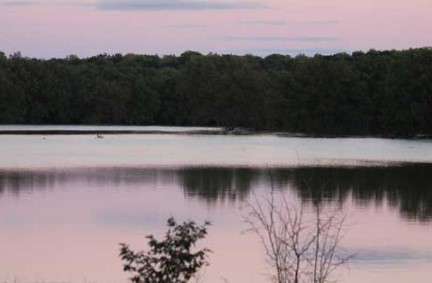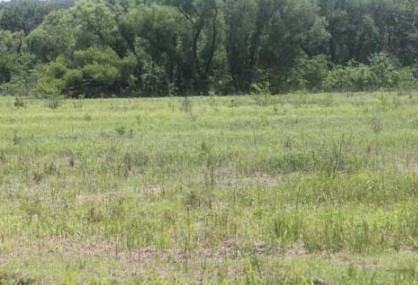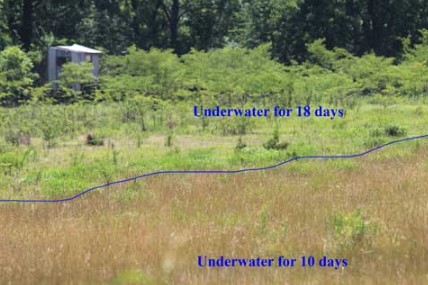Excessive rainfall across much of Kansas this spring led to flooding in many locations. Vegetation response to flooding depends primarily on duration and frequency. Flooding impacts the amount of oxygen, carbon dioxide, temperature, and light available for photosynthesis. Impeded gas exchange results in a depletion of carbohydrate reserves, reduced energy available to the plant, disruption of cellular function, and impairs nutrient uptake, resulting in plant death. Loss of vegetation is also temperature dependent. It takes fewer days of submergence to cause stand loss as soil temperatures increase.
Most annual crops such as wheat, rye, oats, and barley tolerate only brief flooding, i.e. three to six days. Cool-season perennial grasses such as smooth brome (24-28 days) and tall fescue (24-35 days) tolerate longer periods. Bermudagrass is tolerant of very long periods of flooding (45-90 days). Legumes that might be mixed with cool-season grasses including annual lespedeza (5-8 days), red clover (7-15 days), alfalfa (9-12 days), and white clover (10-20 days) are less tolerant to flooding.
Considerable variation exists among native grasses in their tolerance to water submersion. Little bluestem tolerates only brief periods of flooding (3-6 days). Big bluestem and Indiangrass will tolerate only 7-14 days of flooding, whereas switchgrass tolerates 15-30 days. Eastern gamagrass will tolerate 10-22 days. Although buffalograss is shorter than most species, it will tolerate 45-90 days of standing water. A lowland species that is known to tolerate greater than 49 days of flooding is reed canarygrass.
Some invasive species such as yellow bluestem (3-6 days) and sericea lespedeza (10 days) have limited flood tolerance.
Flooding may indeed kill or damage many species, but certain species may survive. Sand deposition and lack of vegetative cover may require reseeding of flood-damaged areas. Consider planting species that are more tolerant of flooding, especially frequently flooded sites.

Figure 1. Pasture flooded in May 2019. Depth finder indicated 12 feet of water in the center of the native range/50% fescue pasture. Water standing on the surface for 25 days. Photo by Jaymelynn Farney, K-State Research and Extension.

Figure 2. Same pasture as in Figure 1 one month after water receded. Before the flooding, the pasture contained heavy grass and forbs, numerous cedar trees, and no bare spots. After the flood, the cedar trees and other brushy plants appear dead. Reed canary grass and other marsh grasses represent current visible growth. Photo by Jaymelynn Farney, K-State Research and Extension.

Figure 3. Fescue pasture that was underwater for up to 18 days. Area towards the back of the photo had water up to the base of the hunting blind, 10 feet off the ground. Now, forage composition predominately reed canary grass. Brush and cedar trees do not seem to be impacted in this area. In foreground, uphill side of pasture was underwater for 10 days and still has solid stand of fescue and forbs. Photo by Jaymelynn Farney, K-State Research and Extension.
Source: ksu.edu